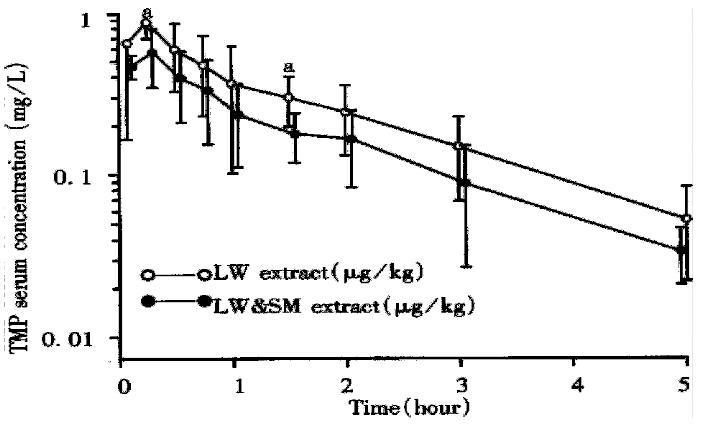Copyright
©The Author(s) 2000.
World J Gastroenterol. Jun 15, 2000; 6(3): 384-391
Published online Jun 15, 2000. doi: 10.3748/wjg.v6.i3.384
Published online Jun 15, 2000. doi: 10.3748/wjg.v6.i3.384
Figure 1 HPLC chromatography of A: TMP (methaqualone, IS) added to rat serum; B: FA (coumarin, IS) in rabbit serum 1: FA (tR:3.
82 min), 2: coumarin (tR: 7.68 min); C: serum sample after oral administ ration of LWandSM extracts in rats; D: sample serum after oral administration of TMPP. 1: TMP (tR: 3.992 min). 2: coumarin (tR: 6.233 min). 3: methanol (tR: 1.017); 4, 5: impurities in serum (tR: 1.725 min and tR: 2.467 min); 6, 7: unknown components (tR: 3.000 min and tR: 3.201 min)
Figure 2 TMP concentration-time curve in serum after oral administration of TMPP in healthy rat (n = 6), RMSDS (n = 6) and RMSDS treated by SJZD (n = 6), aP < 0.
05 vs; bP < 0.01 vs healthy rat.
Figure 3 FA concentration-time curve in serum after intravenous administration of sodium ferulate (5 mg/kg).
aP < 0.05; bP < 0.01 vs healthy rabbit.
Figure 4 TMP concentration-time curve in serum after oral administration of boiled water extract to rats.
aP < 0.05 vs LW extract.
- Citation: Huang X, Ren P, Wen AD, Wang LL, Zhang L, Gao F. Pharmacokinetics of traditional Chinese syndrome and recipe: a hypothesis and its verification (I). World J Gastroenterol 2000; 6(3): 384-391
- URL: https://www.wjgnet.com/1007-9327/full/v6/i3/384.htm
- DOI: https://dx.doi.org/10.3748/wjg.v6.i3.384















